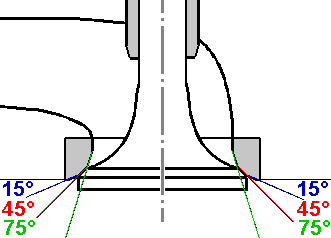|
|
Valve Seats
Assignment
The valve seat, to ensure the sealing, should not be too wide, and to ensure a good heat transfer it should not be too narrow. It must also, even without the previous protective lead coating, maintain it's form.
Function
When overhauling an engine or a cylinder head the valve seats can be reworked and also replaced. Thereby, apart from the valve seat angle of 45°, there are two correction angles of 15° and 75°. Other angles are also
possible. The milling of the valve seats makes the angles wider, the milling of the correction angles makes them narrower.
Material
In todays light-metal cylinder heads, the valve seat rings (e.g., made from stainless steel alloys) have a high resistance to corrosion and wear-and-tear, and are shrunken on.

The valve seat rings are sometimes also an important factor, e.g., for owners of veteran cars, which were accustomed to fuels containin tetraethyl lead. In this case, the valve seats may be missing or are too soft. The valve
wears itself in, becomes leaky and possibly burns out. The most important measure to be observed here, is the frequent checking of the valve-play and of course, the installation of suitable rings during revision of the
cylinder
head.
Indeed, at this point problems can also arise with engines which have been adapted to run on gas. The high strain can also be seen here, when the valves, with their armoured surfaces, after closing thousands of times,
and are abruptly braked on exactly the same spot. At the same time, an intact valve seat guarantees the urgently required heat transfer from the valve-disc to the cylinder head. Of course, it should also have a perfect seal.
Steel alloys are the prevalent valve material, this is the case with the valve seat rings as well, however, they are manufactured in the centrifugal casting process. Thereby, the resulting centrifugal forces give a certain
amount
of structural density. This is completely different with sintering. In this case, metal powders are pre-compressed and, as a relatively loose compound, obtain their structure only with the actual thermal treatment, where only
the compounding portion melts. In both cases, finishing the components to their exact measurements is of course necessary.
The welding of valve- and seat and the subsequent knocking out, is also no longer the last word. They should be precisely routed out, to avoid straining the structure of the cylinder head. In contrast, the installing of the new
seating rings is simple, because with the heat (cylinder head) and cold (valve seat ring) sufficient freedom of movement can be achieved. One should however, take great care that the new rings are properly seated. 02/11
Valve seat rings milling
Press in valve seats
|
|